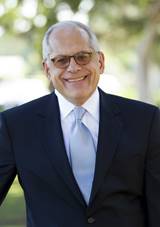
SAN DIEGO (Press Release) — In recognition of Yom Hashoah, members of Bat Harim Hadassah, and community leaders, in San Diego, recently gathered for a presentation and post discussion with William Bernstein, Director of Institutional Advancement for the Western Region, American Society for Yad Vashem.
Bernstein introduced the mission of Yad Vashem by quoting Avner Shalev, the Chairman of the Directorate of Yad Vashem. “…in every generation, we must regard ourselves as if we have personally come forth from Egypt. Each of us is called upon to connect meaningfully with our own past and with our collective heritage.” Bernstein responded, “In essence this theme underlies everything we do at Yad Vashem”.
Yad Vashem (the name means “a memorial and a name”), the World Holocaust Remembrance Center, was founded in 1955 by an act of the Knesset. Perched on top of the Mount of Remembrance in Jerusalem, with expansive views of the city below, Yad Vashem gathers, maintains and curates the largest collection of documentation, artifacts and archives on the Shoah. The campus includes a spectacular museum designed by Moshe Safdi, that meaningfully translates the horrors of the Holocaust, in the hopes of furthering the knowledge and education of the more than 1 million annual visitors. The Yad Vashem facilities include a state of the art research facility, and the educational institute.
Bernstein said that the highest priority of Yad Vashem is Holocaust education. With each generation, students, and often their teachers, are further removed from the history of the Shoah. “I am a staunch believer in Yad Vashem’s sacred mission to educate people around the world to fight hatred, prejudice, and intolerance,” said Bernstein. “For me, at this challenging time in world history, Yad Vashem takes on a very special meaning and responsibility”.
Social and political issues like those that contributed to the rise of the Nazis, more recent civil wars, and genocide, are being seen in various parts of the world. The examples of Rwanda, South Sudan, Biafra and parts of Latin America are potent reminders that without concerted effort, the human tragedy of the Holocaust can raise its head again. Anti-Semitism in the United States surged in 2017, increasing 57% over the previous year and the second highest number of incidents since the Anti-Defamation League began tracking records 40 years ago.
To ensure that the historical lessons of the Holocaust remain top of mind, and increase understanding of issues such as prejudice, intolerance and antisemitism, Yad Vashem has created curriculum for middle and high school students in the United States; a course called Echoes and Reflections. Co-sponsored by the Anti-Defamation League and the Shoah Foundation, Echoes and Reflections has been taught in 10,000 schools to date, with more than 30,000 educators and leaders taking part. The project has provided remarkable results: 3.2 million students have been impacted, and surveys show an 88% increase in student understanding of issues such as prejudice and antisemitism, and 100% increase in students’ knowledge of the Holocaust. An extraordinary 99% of participating teachers would recommend the curriculum to other educators.
Bernstein posits that “…as world population surges, and access to stable food sources and drinking water diminishes, the global conditions become ripe for civil war, violence and genocide. Those who value human rights, democracy and freedom of religious expression must be aware of these circumstances, the lessons of history, and do their best to encourage leaders to act now to avoid risk of human suffering and tragedy”.
Bernstein closed his comments with a poem by Martin Niemoller, a Protestant pastor who was imprisoned in a German concentration camp at the end of WWII.
“First they came for the Socialists and I did not speak out, because I was not a Socialist. Then they came for the Trade Unionists and I did not speak out because I was not a Trade Unionists. Then they came for the Jews and I did not speak out because I was not a Jew. Then they came for me and there was no one left to speak for me.”
For more information about Yad Vashem, and the work of the American Society for Yad Vashem, visit www.yadvashem.org and www.yadvashemusa.org.
*
Preceding provided by the American Society for Yad Vashem